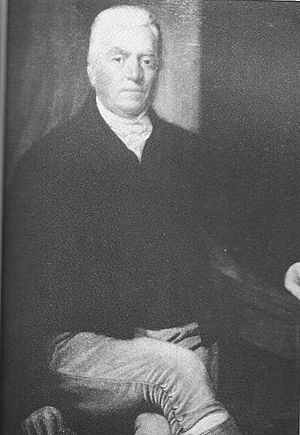Joseph Whidbey facts for kids
Quick facts for kids
Joseph Whidbey
|
|
|---|---|

A Portrait of Joseph Whidbey
|
|
| Born | 1757 |
| Died | 9 October 1833 |
| Allegiance | |
| Service/ |
|
| Years of service | 1779–1830 |
Joseph Whidbey (born 1757, died 1833) was an important person in the Royal Navy, which is the United Kingdom's navy. He was part of the famous Vancouver Expedition from 1791 to 1795. Later, he became a well-known naval engineer. He is famous for being the first European to find and map Admiralty Island in Alaska in 1794.
Not much is known about Joseph Whidbey's early life before he became a sailing master in 1779. After serving for many years during the American War of Independence, he joined the ship HMS Europa. There, he worked with Lieutenant George Vancouver to carefully survey Port Royal in Jamaica.
After the Europa was taken out of service, Whidbey soon joined Vancouver again on a new ship called HMS Discovery. During a time of tension known as the Nootka Crisis, both men were moved to another ship, HMS Courageux. But they soon returned to the Discovery and set sail for the northwest coast of America.
Contents
Exploring the Pacific Northwest
In 1792, Whidbey joined Lieutenant Peter Puget in small boats to explore an area that was later named Puget Sound. On June 2, their team discovered Deception Pass. This discovery proved that the largest island in the Sound was indeed an island. George Vancouver then named this island Whidbey Island in Joseph Whidbey's honor.
A Career in Engineering
After the Discovery returned to England, Whidbey briefly served on HMS Sans Pareil. However, he soon started a career working on land. In 1799, a powerful leader named Earl St Vincent asked him to study if Tor Bay could be made into a safe place for many navy ships. Whidbey suggested building a large breakwater there. It seems he also became good friends and a professional partner with the engineer John Rennie around this time.
Master Attendant at Dockyards
Whidbey was appointed Master Attendant at Sheerness in 1799. This meant he was in charge of all the ships and equipment in the dockyard. He became famous for cleverly salvaging a Dutch ship called the Dutch frigate Ambuscade. He even wrote a paper about it for the Royal Society in 1803. In 1804, he received an even more important job as Master Attendant at Woolwich. This was one of the Royal Navy's biggest dockyards. In 1805, Whidbey became a Fellow of the Royal Society, which is a very high honor for scientists. Many famous scientists supported his nomination.
Building the Plymouth Breakwater
In 1806, as the Napoleonic Wars were about to begin, Whidbey worked with John Rennie to plan the Plymouth Breakwater. This was a huge project requested by Earl St Vincent. In 1811, they were given the order to start building, and Whidbey became the Acting Superintending Engineer.
This project needed amazing engineering, organization, and people skills. There were many technical challenges. Also, a lot of money and resources were used, and different groups wanted to benefit from the project. Nearly 4 million tons of stone were dug up and moved. They used about a dozen special ships that Whidbey and Rennie designed.
Construction started on August 8, 1812. By 1814, it was finished enough to protect large warships. Work continued for over 50 years! It is said that Napoleon himself commented on how grand it was when he sailed past it in 1815 on his way to exile.
Whidbey continued to work on the breakwater and other engineering projects. This included the breakwater's lighthouse, which was designed by Trinity House. He retired around 1830. He also contributed to the Royal Society by writing a paper in 1817 about fossils found in the Plymouth quarries.
Personality and Relationships
Records from the Vancouver Expedition show that Whidbey was a skilled and trustworthy sailor. He was often given difficult tasks. After returning to England, he had a disagreement with George Vancouver over pay. However, Whidbey quickly rose in his career, thanks to his proven technical skills and his connections.
Letters between Whidbey and John Rennie show they had a close and honest working relationship. They also shared a good sense of humor. For example, when someone worried about a large hole in the floor of Plymouth bay, Whidbey joked that if such a hole were found, they would name it after the person who worried about it.
Whidbey's Legacy
It is believed that Whidbey never married or had children. A copy of his will was found in 2022 and is now kept by the South Whidbey Historical Society. The document shows that Whidbey left his wine and spirits to his servants. He also left money to his niece, her daughter, and his friends. He gave a large amount of money to his great-niece, with clear instructions that it should not go to her husband. Whidbey's house near Plymouth is still standing and is called Bovisand House.
Many places around Whidbey Island are named after him. These include Joseph Whidbey State Park and Whidbey Island Naval Air Station. The Whidbey Island-class dock landing ship is also named after the naval air station. In Britain, the Whidbey Automatic Light was built at the eastern end of Plymouth Sound in 1980.
In what is now South Australia, Matthew Flinders named the Whidbey Isles and Point Whidbey in February 1802. He named them "after my worthy friend, the former master-attendant at Sheerness."
Images for kids


